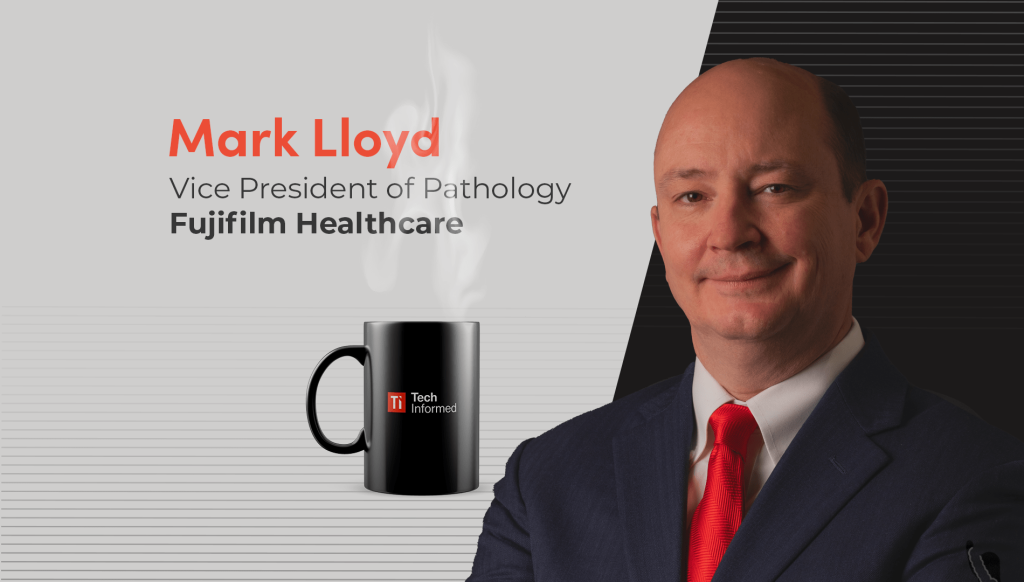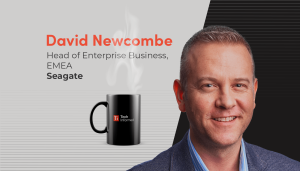

A coffee with…Dr Mark Lloyd, vice president of pathology, Fujifilm Healthcare
Dr Mark Lloyd has worked in digital pathology for over 20 years, combining innovation, entrepreneurship, and a commitment to improving patient care. As head of Fujifilm's digital pathology division, he’s responsible for integrating advanced imaging…
Dr Mark Lloyd has worked in digital pathology for over 20 years, combining innovation, entrepreneurship, and a commitment to improving patient care.
As head of Fujifilm’s digital pathology division, he’s responsible for integrating advanced imaging technologies to enhance diagnostic speed and accuracy.
Lloyd’s career began in the late 90s with a single job interview that led him to the busy, disorganised world of the laboratory — an environment he felt compelled to improve.
During an internship at the National Institutes of Health, he helped develop the first digital pathology system patent by mounting digital cameras on microscopes, a breakthrough that transformed how labs manage specimens.
He continued this work at Georgetown University and later at Moffitt Cancer Center in Florida, where he scaled digital pathology for clinical use. Determined to maximise the impact of his innovations, Lloyd earned an MBA and founded 2DP, a company that grew into a $250m business.
Motivated by his goal to positively impact a billion lives, Lloyd joined Fujifilm following its acquisition of Inspirata’s digital pathology business in 2023.
What would you say are the biggest challenges facing your industry right now?
Globally, pathology is becoming increasingly digital. In countries like the UK and Canada, where governments fund healthcare technology, we’ve seen strong adoption of digital pathology solutions. Large-scale deployments in these regions have had a significant impact on patient care.
In the US, the healthcare system is different, relying heavily on reimbursement. Digital pathology currently falls under a ‘category three’ code, meaning there’s no associated funding.
The American Medical Association is still working on setting appropriate reimbursement codes, which creates a major challenge. Without clear funding pathways, smaller hospitals often struggle to invest in innovative technology.
How do you think Fujifilm is best placed to alleviate some of those challenges?
At Fujifilm, we’ve built our business around demonstrating return on investment in other ways — such as reducing diagnosis times, eliminating the need for couriers, and preventing specimen loss.
We’ve also helped hospitals move away from storing large volumes of glass slides, which has been particularly valuable for organisations facing logistical challenges — whether that’s transporting pathologists across regions or recruiting staff in rural areas.
Our approach is highly tailored to each hospital’s unique needs, which is valuable but also challenging since there’s no one-size-fits-all solution. We focus heavily on consultative selling, helping hospitals understand how digital pathology can benefit them.
Looking ahead, I believe reimbursement will eventually move from its current classification to one tied to funding, which will open the floodgates for wider adoption across US healthcare.
Fujifilm’s strength lies in our enterprise imaging support. Hospital leaders — from chief medical officers to IT directors — see the value in having comprehensive solutions that integrate radiology, cardiology, and pathology under one system. This holistic approach has been key, though there’s still more we can do to encourage innovation adoption.
How does AI fit into that?
AI is crucial to the success of digital pathology. In the past, when we relied on glass slides and paper, we couldn’t use these tools — there was no digital image for AI to analyse. Now that we have digitised data, an entire industry is emerging to support doctors with tools like malignancy detectors, tuberculosis detectors, and quality control systems — tasks that computers excel at.
We see ourselves as creating the building blocks for these AI technologies to thrive. I believe digital pathology cannot succeed without AI; it’s a transformative tool that will continue to enhance and support pathologists. We’ve already seen its impact, and I’m confident this will only grow.
What challenges have you had to overcome in your career?
One of the biggest challenges with any innovative technology is simply getting it started. Many great ideas never leave the laboratory — often due to lack of funding, poor timing, or a lack of belief in the concept. I was fortunate to meet the right people at the right time who helped me overcome that.
Transitioning an idea from the lab to the commercial world is difficult, especially when you’re not replacing outdated equipment but introducing something entirely new. Creating a clear vision for why this technology mattered — and convincing others to invest in it — was crucial.
Coming from a laboratory background myself, I initially found it intimidating to stand on stage and present to business professionals, whom I perceived as being from a different world. Finding mentors who coached me on communication skills, resilience, and how to handle setbacks was incredibly valuable.
I believe these skills aren’t always innate; they’re often learned through real-life experiences. For me, having the right mentors made all the difference.
Have some of your personal or career experiences influenced how you think about patients?
Unfortunately, most of us know someone who has faced a serious illness — and I’m no different. I draw from my own experiences to try and make a positive impact.
One example is my father, who regularly has basal cell carcinomas removed. While these are common and usually harmless, samples sometimes need to be sent to specialist dermatopathologists to rule out melanoma, a far more serious condition. Because we live in rural Virginia, these samples are often sent to specialists in places like California or Boston, leaving my parents waiting anxiously for up to two weeks for results.
I’ve seen first-hand how difficult that waiting period can be — emotionally, physically, and sometimes financially. That’s why I’m passionate about improving diagnostic speed and accuracy. By enabling quicker, more precise diagnoses, I hope patients can get the answers they need and start the right treatment as soon as possible.
What would you say is your most valued or favourite piece of technology that you own?
I like to call my phone “pocket magic” because it’s incredible how much it can do. The fact that I can FaceTime my child while I’m away at a conference, or connect with my grandmother, still amazes me. She’ll often ask if it’s long distance — and I have to remind her, “It’s all free now!”
We often take that magic for granted and that same concept extends to healthcare too — telemedicine became essential during the pandemic, and telepathology is just as powerful. Pathologists who once had to be in the same room, looking at the same microscope, can now collaborate remotely. It’s also a fantastic tool for teaching the next generation of pathologists.
What’s your coffee order?
I am an Americano standard. Very drab kind of coffee order, but I do take it with milk.
Other than caffeine or coffee. How do you recharge?
Vacation. And when I go on vacation, I get away. I like to be in the woods. I like to be out of communication. I will be on the Appalachian Trail. I’ll be on a 100-mile canoe trip. I’ll be in Belize diving. It’s a great time for me to disconnect from the day-to-day but also to come back feeling like a million bucks, and that really matters to me.











